NRSG367 Clinical Reflection: Medication Safety and Error Analysis
VerifiedAdded on 2022/08/20
|6
|1584
|14
Essay
AI Summary
This essay is a reflective account of a medication error that occurred during a nursing student's clinical placement in a cardiac ward. The student describes an incident where a buddy nurse administered the wrong medication to a patient, leading to a rapid deterioration of the patient's condition. The reflection follows Gibbs' Reflective Cycle, detailing the situation, the student's feelings, an evaluation of the response, an analysis of the error in relation to medication safety standards and potential consequences, and a conclusion summarizing the lessons learned. The essay emphasizes the importance of adhering to the rights of medication administration and proposes an action plan for improving communication and preventing future errors, referencing relevant literature on medication safety and error prevention.
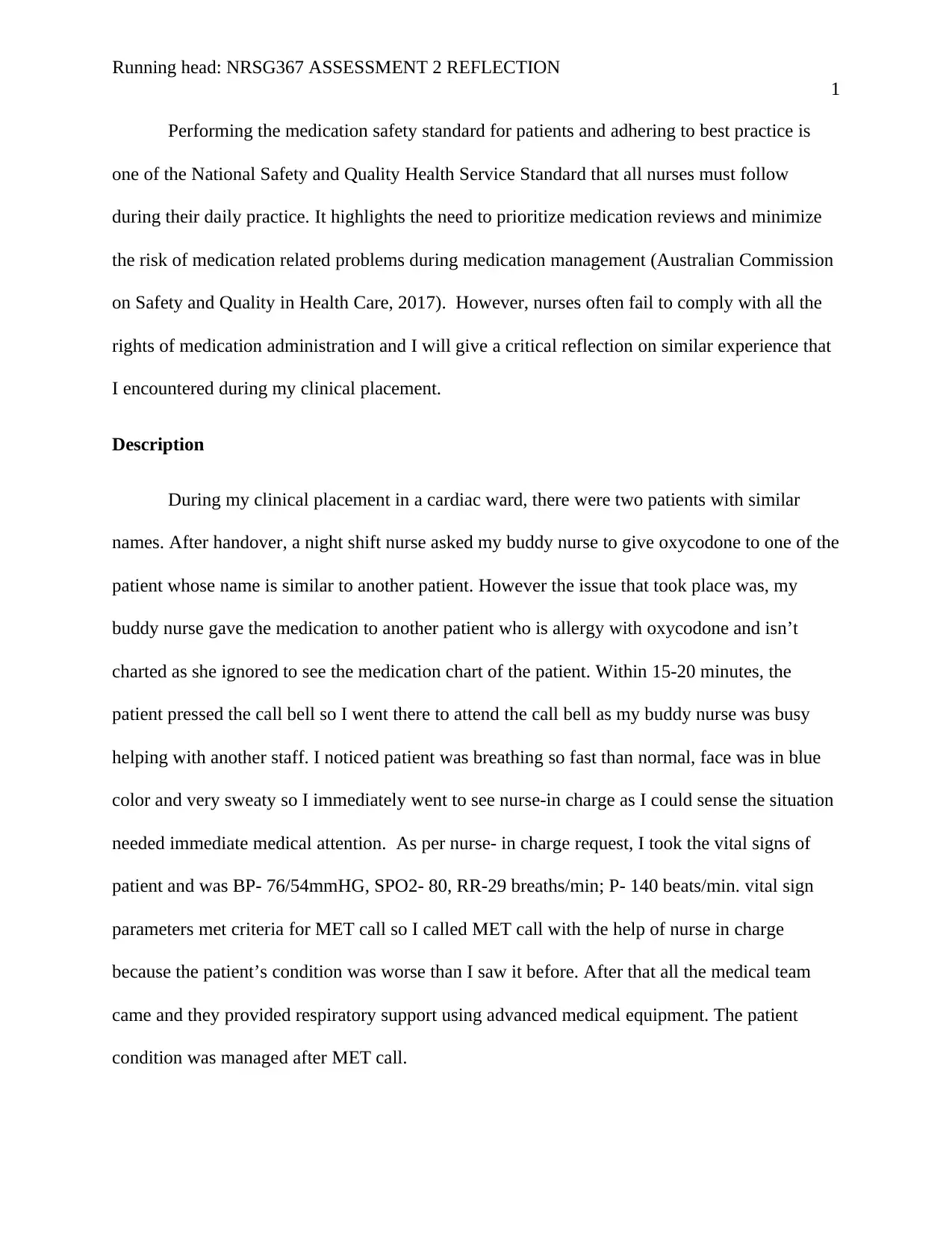
Running head: NRSG367 ASSESSMENT 2 REFLECTION
1
Performing the medication safety standard for patients and adhering to best practice is
one of the National Safety and Quality Health Service Standard that all nurses must follow
during their daily practice. It highlights the need to prioritize medication reviews and minimize
the risk of medication related problems during medication management (Australian Commission
on Safety and Quality in Health Care, 2017). However, nurses often fail to comply with all the
rights of medication administration and I will give a critical reflection on similar experience that
I encountered during my clinical placement.
Description
During my clinical placement in a cardiac ward, there were two patients with similar
names. After handover, a night shift nurse asked my buddy nurse to give oxycodone to one of the
patient whose name is similar to another patient. However the issue that took place was, my
buddy nurse gave the medication to another patient who is allergy with oxycodone and isn’t
charted as she ignored to see the medication chart of the patient. Within 15-20 minutes, the
patient pressed the call bell so I went there to attend the call bell as my buddy nurse was busy
helping with another staff. I noticed patient was breathing so fast than normal, face was in blue
color and very sweaty so I immediately went to see nurse-in charge as I could sense the situation
needed immediate medical attention. As per nurse- in charge request, I took the vital signs of
patient and was BP- 76/54mmHG, SPO2- 80, RR-29 breaths/min; P- 140 beats/min. vital sign
parameters met criteria for MET call so I called MET call with the help of nurse in charge
because the patient’s condition was worse than I saw it before. After that all the medical team
came and they provided respiratory support using advanced medical equipment. The patient
condition was managed after MET call.
1
Performing the medication safety standard for patients and adhering to best practice is
one of the National Safety and Quality Health Service Standard that all nurses must follow
during their daily practice. It highlights the need to prioritize medication reviews and minimize
the risk of medication related problems during medication management (Australian Commission
on Safety and Quality in Health Care, 2017). However, nurses often fail to comply with all the
rights of medication administration and I will give a critical reflection on similar experience that
I encountered during my clinical placement.
Description
During my clinical placement in a cardiac ward, there were two patients with similar
names. After handover, a night shift nurse asked my buddy nurse to give oxycodone to one of the
patient whose name is similar to another patient. However the issue that took place was, my
buddy nurse gave the medication to another patient who is allergy with oxycodone and isn’t
charted as she ignored to see the medication chart of the patient. Within 15-20 minutes, the
patient pressed the call bell so I went there to attend the call bell as my buddy nurse was busy
helping with another staff. I noticed patient was breathing so fast than normal, face was in blue
color and very sweaty so I immediately went to see nurse-in charge as I could sense the situation
needed immediate medical attention. As per nurse- in charge request, I took the vital signs of
patient and was BP- 76/54mmHG, SPO2- 80, RR-29 breaths/min; P- 140 beats/min. vital sign
parameters met criteria for MET call so I called MET call with the help of nurse in charge
because the patient’s condition was worse than I saw it before. After that all the medical team
came and they provided respiratory support using advanced medical equipment. The patient
condition was managed after MET call.
Paraphrase This Document
Need a fresh take? Get an instant paraphrase of this document with our AI Paraphraser
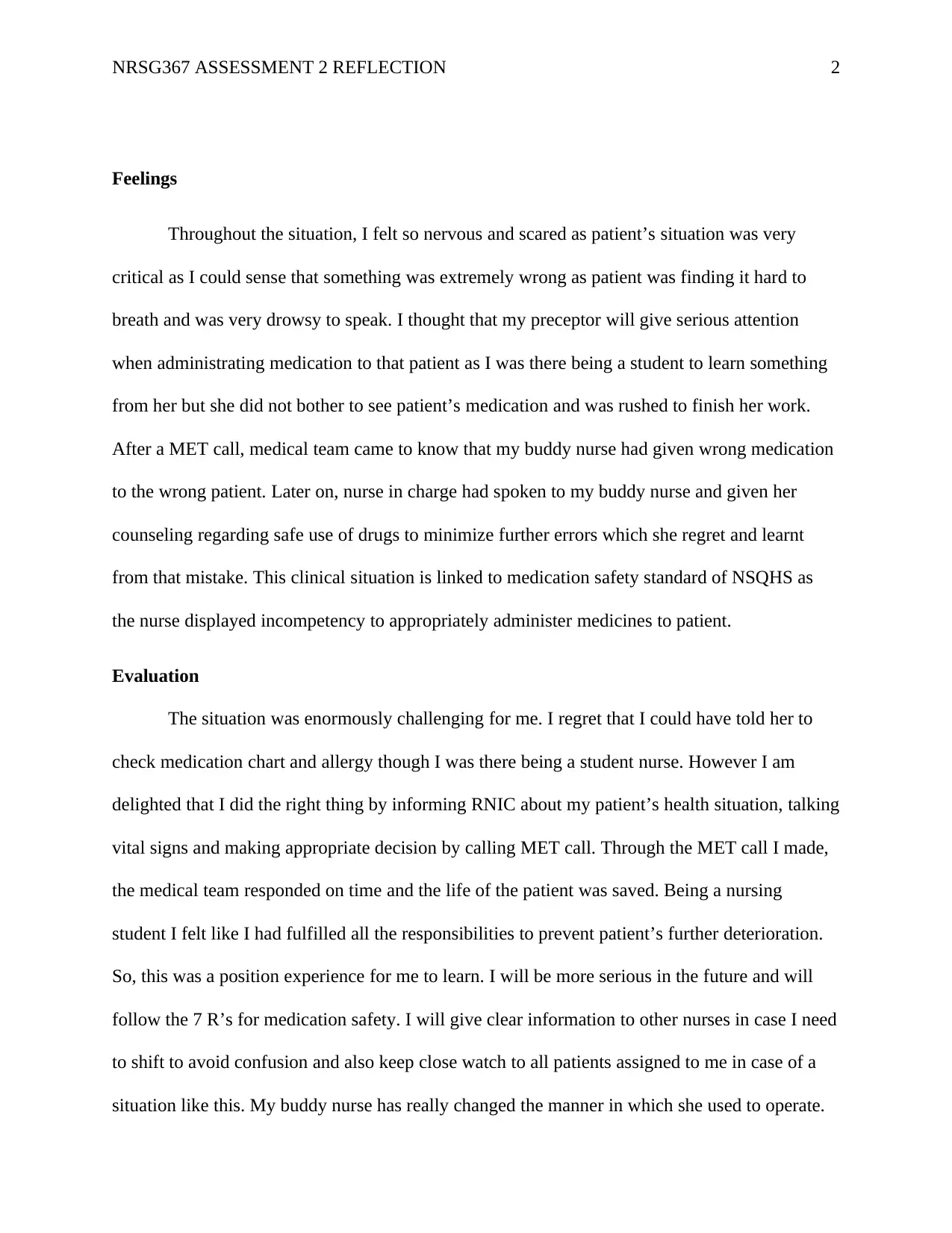
NRSG367 ASSESSMENT 2 REFLECTION 2
Feelings
Throughout the situation, I felt so nervous and scared as patient’s situation was very
critical as I could sense that something was extremely wrong as patient was finding it hard to
breath and was very drowsy to speak. I thought that my preceptor will give serious attention
when administrating medication to that patient as I was there being a student to learn something
from her but she did not bother to see patient’s medication and was rushed to finish her work.
After a MET call, medical team came to know that my buddy nurse had given wrong medication
to the wrong patient. Later on, nurse in charge had spoken to my buddy nurse and given her
counseling regarding safe use of drugs to minimize further errors which she regret and learnt
from that mistake. This clinical situation is linked to medication safety standard of NSQHS as
the nurse displayed incompetency to appropriately administer medicines to patient.
Evaluation
The situation was enormously challenging for me. I regret that I could have told her to
check medication chart and allergy though I was there being a student nurse. However I am
delighted that I did the right thing by informing RNIC about my patient’s health situation, talking
vital signs and making appropriate decision by calling MET call. Through the MET call I made,
the medical team responded on time and the life of the patient was saved. Being a nursing
student I felt like I had fulfilled all the responsibilities to prevent patient’s further deterioration.
So, this was a position experience for me to learn. I will be more serious in the future and will
follow the 7 R’s for medication safety. I will give clear information to other nurses in case I need
to shift to avoid confusion and also keep close watch to all patients assigned to me in case of a
situation like this. My buddy nurse has really changed the manner in which she used to operate.
Feelings
Throughout the situation, I felt so nervous and scared as patient’s situation was very
critical as I could sense that something was extremely wrong as patient was finding it hard to
breath and was very drowsy to speak. I thought that my preceptor will give serious attention
when administrating medication to that patient as I was there being a student to learn something
from her but she did not bother to see patient’s medication and was rushed to finish her work.
After a MET call, medical team came to know that my buddy nurse had given wrong medication
to the wrong patient. Later on, nurse in charge had spoken to my buddy nurse and given her
counseling regarding safe use of drugs to minimize further errors which she regret and learnt
from that mistake. This clinical situation is linked to medication safety standard of NSQHS as
the nurse displayed incompetency to appropriately administer medicines to patient.
Evaluation
The situation was enormously challenging for me. I regret that I could have told her to
check medication chart and allergy though I was there being a student nurse. However I am
delighted that I did the right thing by informing RNIC about my patient’s health situation, talking
vital signs and making appropriate decision by calling MET call. Through the MET call I made,
the medical team responded on time and the life of the patient was saved. Being a nursing
student I felt like I had fulfilled all the responsibilities to prevent patient’s further deterioration.
So, this was a position experience for me to learn. I will be more serious in the future and will
follow the 7 R’s for medication safety. I will give clear information to other nurses in case I need
to shift to avoid confusion and also keep close watch to all patients assigned to me in case of a
situation like this. My buddy nurse has really changed the manner in which she used to operate.
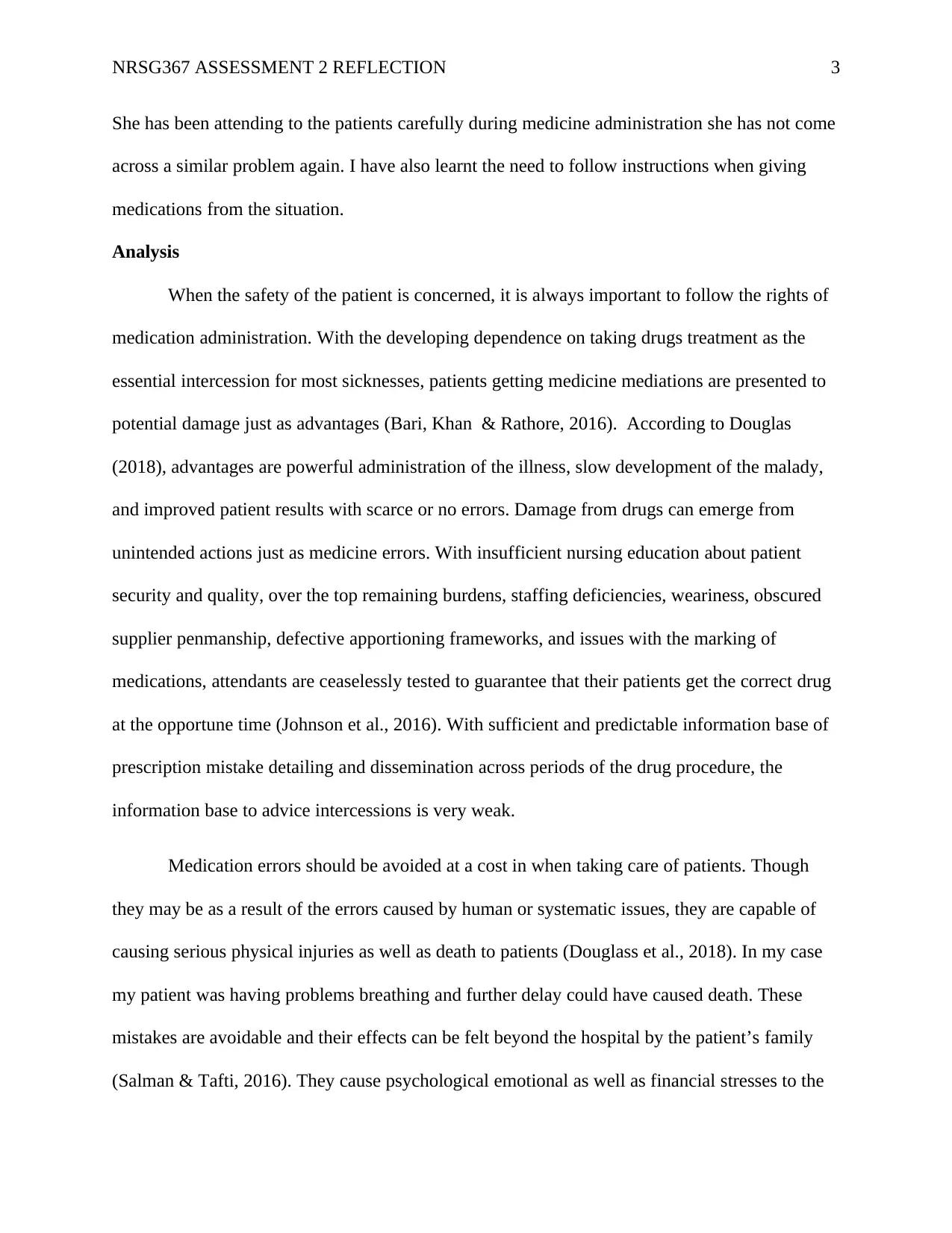
NRSG367 ASSESSMENT 2 REFLECTION 3
She has been attending to the patients carefully during medicine administration she has not come
across a similar problem again. I have also learnt the need to follow instructions when giving
medications from the situation.
Analysis
When the safety of the patient is concerned, it is always important to follow the rights of
medication administration. With the developing dependence on taking drugs treatment as the
essential intercession for most sicknesses, patients getting medicine mediations are presented to
potential damage just as advantages (Bari, Khan & Rathore, 2016). According to Douglas
(2018), advantages are powerful administration of the illness, slow development of the malady,
and improved patient results with scarce or no errors. Damage from drugs can emerge from
unintended actions just as medicine errors. With insufficient nursing education about patient
security and quality, over the top remaining burdens, staffing deficiencies, weariness, obscured
supplier penmanship, defective apportioning frameworks, and issues with the marking of
medications, attendants are ceaselessly tested to guarantee that their patients get the correct drug
at the opportune time (Johnson et al., 2016). With sufficient and predictable information base of
prescription mistake detailing and dissemination across periods of the drug procedure, the
information base to advice intercessions is very weak.
Medication errors should be avoided at a cost in when taking care of patients. Though
they may be as a result of the errors caused by human or systematic issues, they are capable of
causing serious physical injuries as well as death to patients (Douglass et al., 2018). In my case
my patient was having problems breathing and further delay could have caused death. These
mistakes are avoidable and their effects can be felt beyond the hospital by the patient’s family
(Salman & Tafti, 2016). They cause psychological emotional as well as financial stresses to the
She has been attending to the patients carefully during medicine administration she has not come
across a similar problem again. I have also learnt the need to follow instructions when giving
medications from the situation.
Analysis
When the safety of the patient is concerned, it is always important to follow the rights of
medication administration. With the developing dependence on taking drugs treatment as the
essential intercession for most sicknesses, patients getting medicine mediations are presented to
potential damage just as advantages (Bari, Khan & Rathore, 2016). According to Douglas
(2018), advantages are powerful administration of the illness, slow development of the malady,
and improved patient results with scarce or no errors. Damage from drugs can emerge from
unintended actions just as medicine errors. With insufficient nursing education about patient
security and quality, over the top remaining burdens, staffing deficiencies, weariness, obscured
supplier penmanship, defective apportioning frameworks, and issues with the marking of
medications, attendants are ceaselessly tested to guarantee that their patients get the correct drug
at the opportune time (Johnson et al., 2016). With sufficient and predictable information base of
prescription mistake detailing and dissemination across periods of the drug procedure, the
information base to advice intercessions is very weak.
Medication errors should be avoided at a cost in when taking care of patients. Though
they may be as a result of the errors caused by human or systematic issues, they are capable of
causing serious physical injuries as well as death to patients (Douglass et al., 2018). In my case
my patient was having problems breathing and further delay could have caused death. These
mistakes are avoidable and their effects can be felt beyond the hospital by the patient’s family
(Salman & Tafti, 2016). They cause psychological emotional as well as financial stresses to the
⊘ This is a preview!⊘
Do you want full access?
Subscribe today to unlock all pages.

Trusted by 1+ million students worldwide
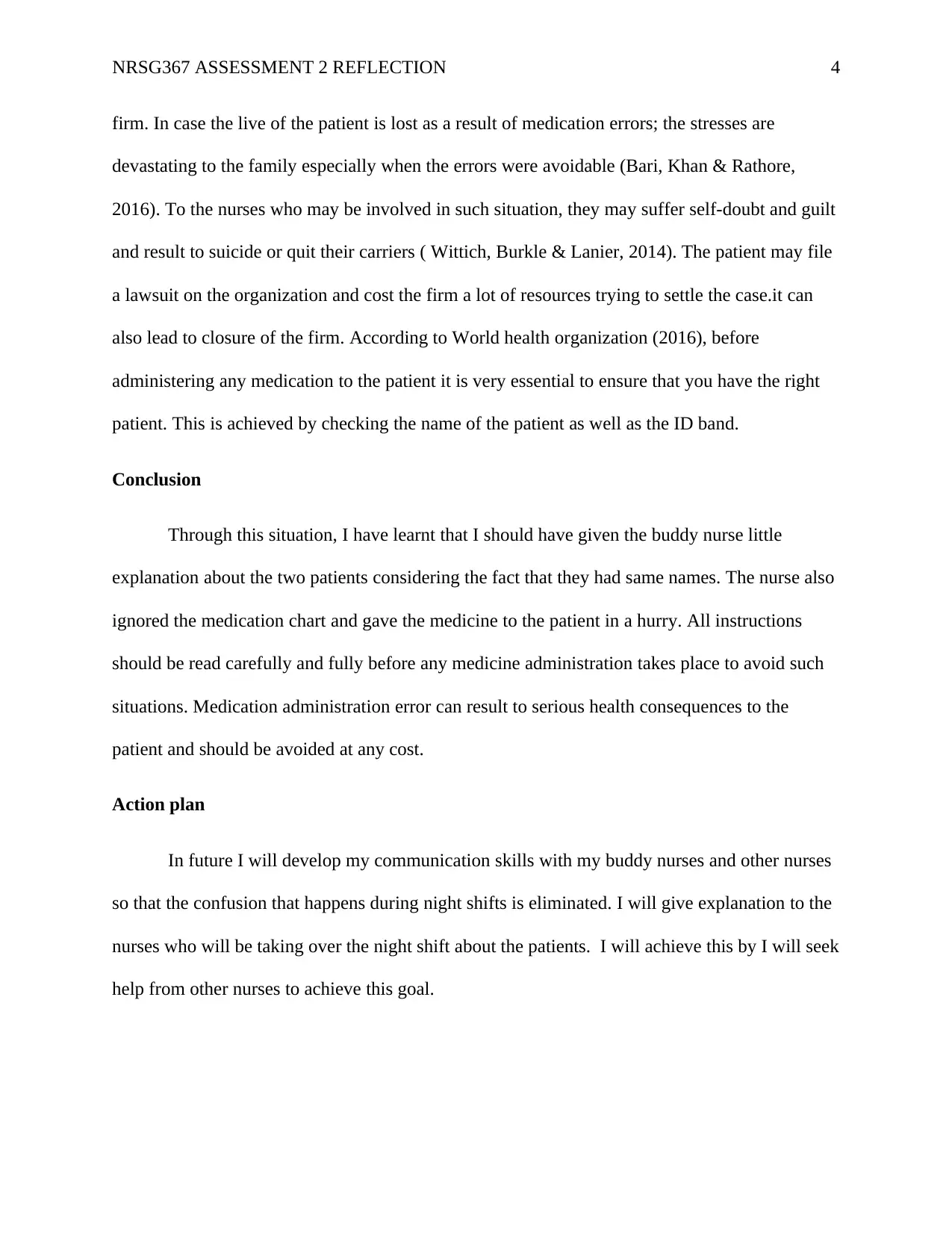
NRSG367 ASSESSMENT 2 REFLECTION 4
firm. In case the live of the patient is lost as a result of medication errors; the stresses are
devastating to the family especially when the errors were avoidable (Bari, Khan & Rathore,
2016). To the nurses who may be involved in such situation, they may suffer self-doubt and guilt
and result to suicide or quit their carriers ( Wittich, Burkle & Lanier, 2014). The patient may file
a lawsuit on the organization and cost the firm a lot of resources trying to settle the case.it can
also lead to closure of the firm. According to World health organization (2016), before
administering any medication to the patient it is very essential to ensure that you have the right
patient. This is achieved by checking the name of the patient as well as the ID band.
Conclusion
Through this situation, I have learnt that I should have given the buddy nurse little
explanation about the two patients considering the fact that they had same names. The nurse also
ignored the medication chart and gave the medicine to the patient in a hurry. All instructions
should be read carefully and fully before any medicine administration takes place to avoid such
situations. Medication administration error can result to serious health consequences to the
patient and should be avoided at any cost.
Action plan
In future I will develop my communication skills with my buddy nurses and other nurses
so that the confusion that happens during night shifts is eliminated. I will give explanation to the
nurses who will be taking over the night shift about the patients. I will achieve this by I will seek
help from other nurses to achieve this goal.
firm. In case the live of the patient is lost as a result of medication errors; the stresses are
devastating to the family especially when the errors were avoidable (Bari, Khan & Rathore,
2016). To the nurses who may be involved in such situation, they may suffer self-doubt and guilt
and result to suicide or quit their carriers ( Wittich, Burkle & Lanier, 2014). The patient may file
a lawsuit on the organization and cost the firm a lot of resources trying to settle the case.it can
also lead to closure of the firm. According to World health organization (2016), before
administering any medication to the patient it is very essential to ensure that you have the right
patient. This is achieved by checking the name of the patient as well as the ID band.
Conclusion
Through this situation, I have learnt that I should have given the buddy nurse little
explanation about the two patients considering the fact that they had same names. The nurse also
ignored the medication chart and gave the medicine to the patient in a hurry. All instructions
should be read carefully and fully before any medicine administration takes place to avoid such
situations. Medication administration error can result to serious health consequences to the
patient and should be avoided at any cost.
Action plan
In future I will develop my communication skills with my buddy nurses and other nurses
so that the confusion that happens during night shifts is eliminated. I will give explanation to the
nurses who will be taking over the night shift about the patients. I will achieve this by I will seek
help from other nurses to achieve this goal.
Paraphrase This Document
Need a fresh take? Get an instant paraphrase of this document with our AI Paraphraser
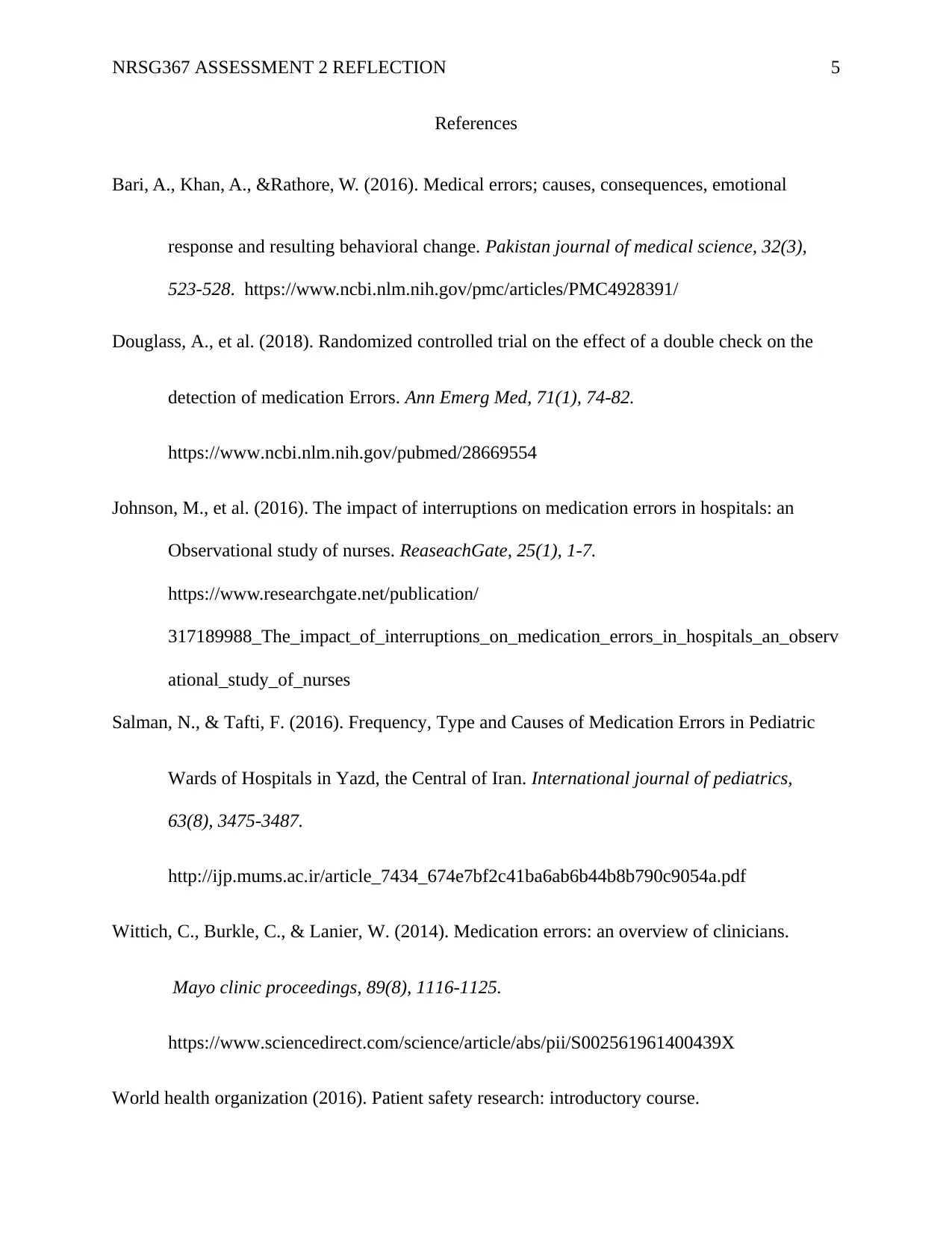
NRSG367 ASSESSMENT 2 REFLECTION 5
References
Bari, A., Khan, A., &Rathore, W. (2016). Medical errors; causes, consequences, emotional
response and resulting behavioral change. Pakistan journal of medical science, 32(3),
523-528. https://www.ncbi.nlm.nih.gov/pmc/articles/PMC4928391/
Douglass, A., et al. (2018). Randomized controlled trial on the effect of a double check on the
detection of medication Errors. Ann Emerg Med, 71(1), 74-82.
https://www.ncbi.nlm.nih.gov/pubmed/28669554
Johnson, M., et al. (2016). The impact of interruptions on medication errors in hospitals: an
Observational study of nurses. ReaseachGate, 25(1), 1-7.
https://www.researchgate.net/publication/
317189988_The_impact_of_interruptions_on_medication_errors_in_hospitals_an_observ
ational_study_of_nurses
Salman, N., & Tafti, F. (2016). Frequency, Type and Causes of Medication Errors in Pediatric
Wards of Hospitals in Yazd, the Central of Iran. International journal of pediatrics,
63(8), 3475-3487.
http://ijp.mums.ac.ir/article_7434_674e7bf2c41ba6ab6b44b8b790c9054a.pdf
Wittich, C., Burkle, C., & Lanier, W. (2014). Medication errors: an overview of clinicians.
Mayo clinic proceedings, 89(8), 1116-1125.
https://www.sciencedirect.com/science/article/abs/pii/S002561961400439X
World health organization (2016). Patient safety research: introductory course.
References
Bari, A., Khan, A., &Rathore, W. (2016). Medical errors; causes, consequences, emotional
response and resulting behavioral change. Pakistan journal of medical science, 32(3),
523-528. https://www.ncbi.nlm.nih.gov/pmc/articles/PMC4928391/
Douglass, A., et al. (2018). Randomized controlled trial on the effect of a double check on the
detection of medication Errors. Ann Emerg Med, 71(1), 74-82.
https://www.ncbi.nlm.nih.gov/pubmed/28669554
Johnson, M., et al. (2016). The impact of interruptions on medication errors in hospitals: an
Observational study of nurses. ReaseachGate, 25(1), 1-7.
https://www.researchgate.net/publication/
317189988_The_impact_of_interruptions_on_medication_errors_in_hospitals_an_observ
ational_study_of_nurses
Salman, N., & Tafti, F. (2016). Frequency, Type and Causes of Medication Errors in Pediatric
Wards of Hospitals in Yazd, the Central of Iran. International journal of pediatrics,
63(8), 3475-3487.
http://ijp.mums.ac.ir/article_7434_674e7bf2c41ba6ab6b44b8b790c9054a.pdf
Wittich, C., Burkle, C., & Lanier, W. (2014). Medication errors: an overview of clinicians.
Mayo clinic proceedings, 89(8), 1116-1125.
https://www.sciencedirect.com/science/article/abs/pii/S002561961400439X
World health organization (2016). Patient safety research: introductory course.
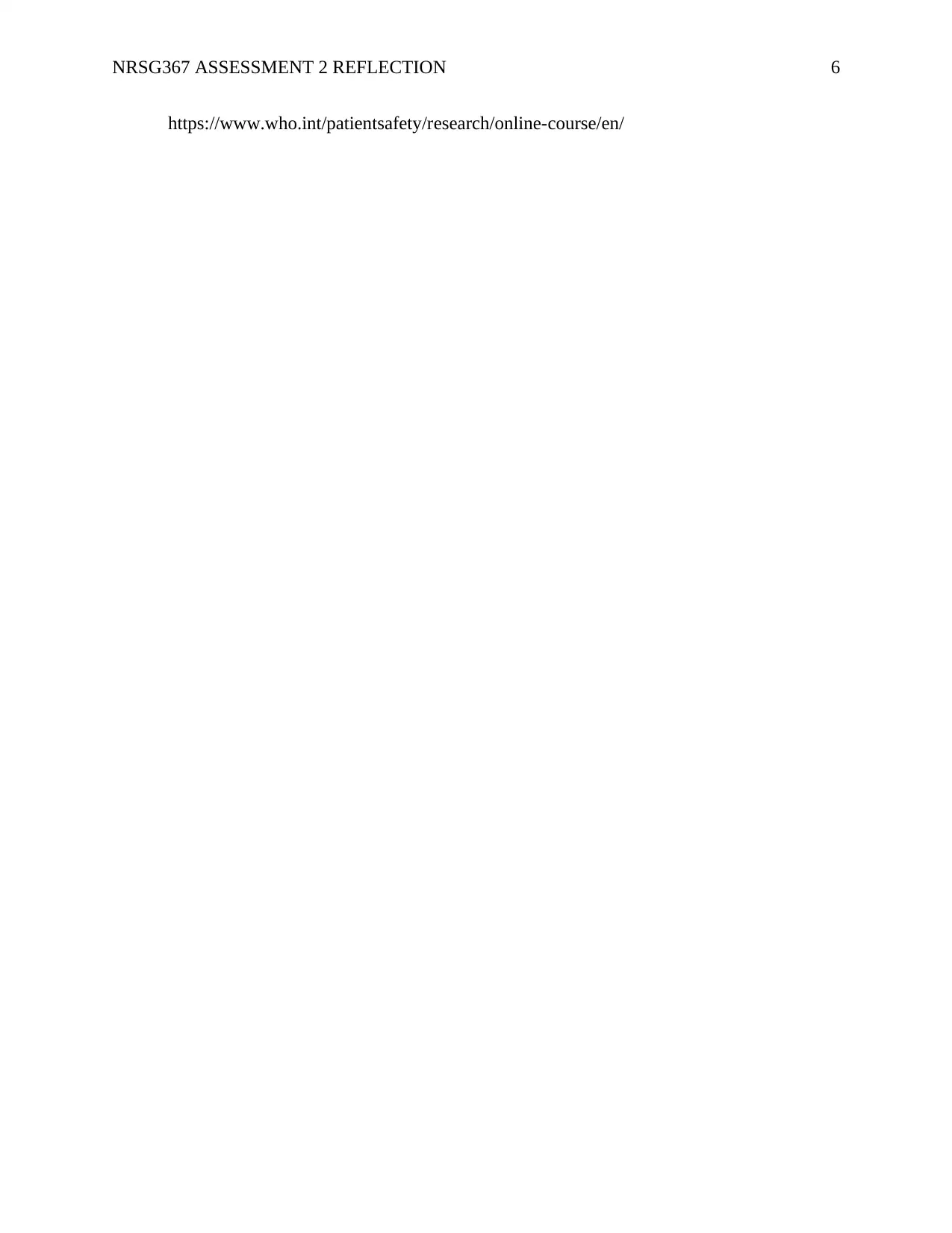
NRSG367 ASSESSMENT 2 REFLECTION 6
https://www.who.int/patientsafety/research/online-course/en/
https://www.who.int/patientsafety/research/online-course/en/
⊘ This is a preview!⊘
Do you want full access?
Subscribe today to unlock all pages.

Trusted by 1+ million students worldwide
1 out of 6
Related Documents
Your All-in-One AI-Powered Toolkit for Academic Success.
+13062052269
info@desklib.com
Available 24*7 on WhatsApp / Email
![[object Object]](/_next/static/media/star-bottom.7253800d.svg)
Unlock your academic potential
Copyright © 2020–2025 A2Z Services. All Rights Reserved. Developed and managed by ZUCOL.





